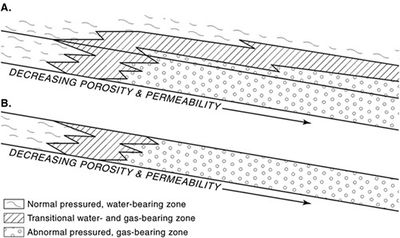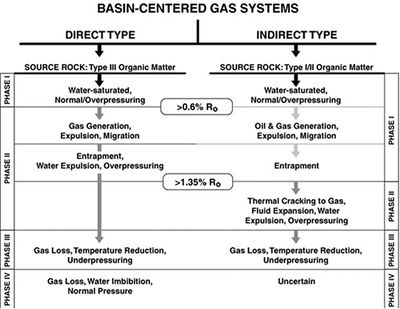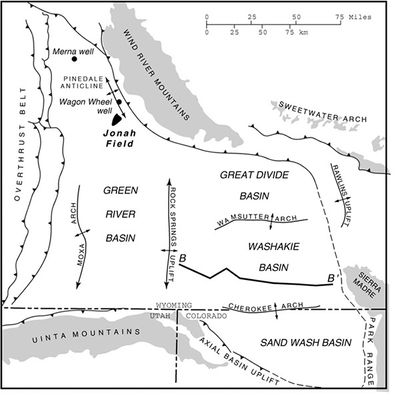Basin-centered gas systems: elements and processes
| Basin-centered gas systems | |
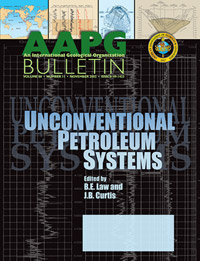
| |
| Series | AAPG Bulletin, November 2002 |
|---|---|
| Author | Ben E. Law |
| Link | Web page |
Source rocks
Source rock quality is the fundamentally most important element distinguishing direct from indirect basin-centered gas systems (BCGSs) and sets the stage for all subsequent differences between the two systems. The source rocks for direct BCGSs are most commonly humic-type coal beds and carbonaceous shale, such as occur in Cretaceous rocks in most Rocky Mountain basins or Carboniferous rocks in Europe. Source rocks for indirect BCGSs are hydrogen-rich shales such as those in the Ordovician shale in the Appalachian basin or in Silurian shales in the Middle East and North Africa. Garcia-Gonzales et al.,[1][2] MacGowan et al.,[3] and Surdam et al.[4] concluded that some of the coal beds in the Greater Green River basin of Wyoming (Upper Cretaceous Almond coal beds) generated liquid hydrocarbons that were subsequently thermally cracked to gas, while still in the coal beds. They further speculated that, because of the increased fluid volume associated with the oil to gas transformation, high pressures created fractures within the coal beds, facilitating the expulsion of gas. The gas then migrated and accumulated in low-permeability reservoirs. Law[5] concluded that all, or most, of the gas in low-permeability reservoirs in the Greater Green River basin was sourced from humic, type III organic matter contained in coal beds and carbonaceous shale in several coal-bearing Upper Cretaceous intervals. The relative contribution of gas to basin-centered gas accumulation (BCGA) reservoirs from these different processes is not known. In the Greater Green River basin BCGA, the gas likely is dominantly sourced directly from gas-prone, humic coal beds in the Lance, Almond, and Rock Springs formations, with a minor contribution from the cracking of oil to gas in Almond Formation coal beds in the very deepest part of the Great Divide and Washakie basins.
Reservoir rock
Gas-charged reservoirs in direct and indirect BCGSs are regionally pervasive, commonly encompassing several thousand square miles, and may consist of single, isolated reservoirs a few feet thick or vertically stacked reservoirs several thousand feet thick. Multiple, stacked reservoirs are common in direct BCGSs, whereas single, discrete reservoirs are common in indirect BCGSs. Direct and indirect reservoirs always exhibit low porosity (<13%) and low, in-situ permeability (<0.1 md).[6][7] They are composed of sandstone, siltstone, and, to a much lesser degree, carbonates; the only occurrence of a BCGA carbonate reservoir is in the Sichuan basin of China.[8] The environments of deposition of BCGA reservoirs range from marine to nonmarine. Reservoirs are gas-saturated, with little or no producible water, and are downdip from water-bearing reservoirs (Figure 1), a reversal of conditions found in conventional gas systems.[9][5][6][7]
The BCGS reservoirs can be divided into lenticular and blanket reservoirs.[10][6][7] Lenticular reservoirs, such as small, fluvial channel sandstones, typically have a limited pore volume and very low permeability. In contrast, blanketlike reservoirs, such as braided stream, delta front, and eolian sandstones, typically have very large pore volumes and relatively better permeability than lenticular reservoirs. The distinction between these types of reservoirs becomes important when attempting to distinguish between gas- and water-bearing reservoirs and is an important factor in the design of drilling and completion programs.
In thick, vertically stacked direct BCGA reservoirs, interbedded water-bearing reservoirs are not uncommon. For example, the blanketlike Upper Cretaceous Ericson Sandstone of the Mesaverde Group in western Wyoming is a water-bearing reservoir interbedded with a regionally pervasive BCGA. Additional examples in western Wyoming of interbedded, water-bearing reservoirs occur in the Upper Cretaceous Frontier and Blair formations, Almond sandstone, and Lewis Shale. Examples of water-bearing reservoirs also exist in the Elmworth field BCGA, Alberta basin, Canada. The Rollins and Trout Creek members of the Mesaverde Formation in the Piceance basin of Colorado are blanket reservoirs that are water bearing.[11] The occurrence of water in thick, BCGA sequences is also possible through the introduction of water along fractures and faults.
Seals
Where detailed work has been conducted in direct BCGAs, gas-saturated reservoirs grade vertically, across stratigraphic boundaries, as well as updip into transitional, water- and gas-bearing zones that, in turn, grade into normally pressured, water-bearing reservoirs (Figure 1). In indirect BCGAs, gas-saturated reservoirs grade updip into transitional, water- and gas-bearing zones; however, vertical transitional zones across bed boundaries do not occur, and there is an abrupt, distinct boundary between the abnormally pressured BCGA and normally pressured, water-bearing reservoirs (Figure 1). The nature of these fluid boundaries is related to seal integrity. Seals in BCGAs range from lithologic to relative permeability, or water-block, seals, referred to in this article as capillary pressure seals. Capillary pressure seals generally occur in reservoirs that have very small pore throats and two or more fluid phases. Under these conditions, the permeability to each fluid phase is effectively reduced.
Because of the nature of seals in direct BCGAs, a question arises concerning the integrity of the seal. Based on burial and thermal history reconstructions, capillary pressure seals in Cretaceous and Tertiary BCGAs in the Rocky Mountain region are effective for periods of time ranging from 25 to 40 m.y., the lapsed time since formation of most BCGAs in the region. However, as a consequence of the nature of these seals, there is a perception that the seals are leaky and, given sufficient time, will degenerate and become ineffective. If the perception of a leaky seal over significantly long periods of time is correct, then one might expect to see a predominance of direct BCGAs in rocks that have experienced the formation of a BCGA within a few tens of million years. Also, in a more general sense, one would expect to observe a higher frequency of direct BCGAs in younger rocks than in older rocks. Observations of known BCGAs are skewed toward Cretaceous systems, largely because most of the work conducted on BCGAs has been in Cretaceous and Tertiary rocks. There are no detailed studies of seal integrity in pre-Cretaceous BCGAs, although Ryder and Zagorski[12] have concluded that the updip seal in the Lower Silurian Clinton-Medina BCGA in the Appalachian basin is a water block. In indirect systems, it is important to distinguish between vertical seals, top seals, and updip seals; in the Clinton-Medina reservoir, there is an apparently effective updip, capillary pressure seal,[12] whereas the upper, top seal is a lithologic seal composed of evaporite, shale, and carbonate.[13]
Hydrocarbon generation, expulsion, and migration
There is a large body of literature concerning hydrocarbon generation, expulsion, and migration (see Hunt[14] for detailed discussions). As depicted in Figure 2, the generation of hydrocarbons from source rocks in direct and indirect BCGSs occurs at levels of thermal maturity exceeding 0.6% Ro.[14] According to Meissner,[15] thermal generation of gas from humid coal beds begins at 0.73% Ro. Peak generation may occur at levels of thermal maturity between 0.8-0.9% Ro.[16] In the Greater Green River basin, measured levels of thermal maturity at the top of direct BCGAs range from 0.7 to 0.9% Ro,[5] implying that source beds for the gas would have levels of thermal maturity equal to or greater than 0.7-0.9% Ro.
The level of thermal maturity marking the transformation of oil to gas in indirect systems (initiation of phase II on Figure 2) is uncertain. Conventional wisdom indicates that thermal cracking of oil to gas occurs at about 1.35% Ro.[16][14] Price[17] questioned this value and concluded that the transformation of oil to gas occurred at much higher levels of thermal maturity. More recent kinetic studies by Tsuzuki et al.[18] using hydrous pyrolysis experiments also suggest that oil is stable over higher levels of thermal maturity than previously thought. Applying these kinetic parameters to burial history curves in the United States Gulf Coast indicates that oil cracking to gas starts at vitrinite reflectance values of 1.75% Ro (M. D. Lewan, 2002, personal communication).
In general, hydrocarbon migration distances in direct BCGSs are short, perhaps on the order of a few hundred feet or less. The exception to short hydrocarbon migration distances may occur in cases where the regional top of a BCGA has been ruptured, facilitating vertical migration of gas along faults and fractures for distances far greater than a few hundred feet, such as in the Jonah field of western Wyoming, discussed below in the Trap formation section.
In indirect BCGSs, hydrocarbon migration distances are highly variable, similar to migration distances in conventional petroleum systems. Approximately 1000 ft (305 m) of vertical migration is proposed for the Clinton-Medina BCGA.[12] In direct BCGSs, gas is the dominant migrating hydrocarbon phase, and in indirect BCGSs, oil and gas may be expected to be the migrating fluid phases.
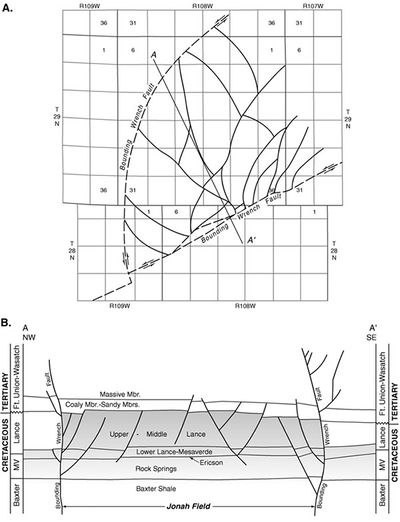
Trap formation
The development of a trap in the conventional sense of a structural or stratigraphic trap is an important process in a petroleum system. In a direct BCGS system, however, it is of secondary importance, whereas in indirect systems it is very important. In direct systems, the top of gas accumulations cuts across structural and stratigraphic boundaries[5][6][20] and is, therefore, not normally dependent on the development of structural or stratigraphic traps. The Jonah field of western Wyoming (Figure 3, Figure 4) is a good example of a direct BCGA in which structural and stratigraphic aspects are important. The lateral boundaries of the field are defined by faults.[21][19][22] The top of the accumulation is defined by a silty shale seal in the Upper Cretaceous Lance Formation.
In the development of indirect BCGAs, a conventional structural or stratigraphic trap is necessary for the accumulation of oil and gas, much the same way as oil and gas accumulate in conventional, buoyancy-driven accumulations. The development of indirect BCGAs occurs at a later burial stage than direct systems, when conventionally accumulated oil is thermally cracked to gas, accompanied by a significant increase in pore fluid volume and pore pressure (Figure 2). Oil, however, does not always accumulate in discrete accumulations and may be disseminated throughout a reservoir. In such cases, the amount of oil in the accumulation may not be present in sufficient quantity to develop pore pressures high enough to form a BCGA during the thermal conversion of oil to gas. Thus, the formation of a suitable trap and the temporal relationships among trap formation and gas generation, expulsion, migration, and entrapment are critical processes in indirect systems.
References
- ↑ Garcia-Gonzales, M., D. B. MacGowan, and R. C. Surdam, 1993, Coal as a source rock of petroleum and gas-a comparison between natural and artificial maturation of the Almond Formation coals, Greater Green River basin in Wyoming, in D. G. Howell, ed., The future of energy gases: U.S. Geological Survey Professional Paper 1570, p. 405-437.
- ↑ Garcia-Gonzales, M., D. B. MacGowan, and R. C. Surdam, 1993, Mechanisms of petroleum generation from coal, as evidenced from petrographic and geochemical studies: Examples from Almond Formation coals in the Greater Green River basin, in B. Strook and S. Andrew, eds., Wyoming Geological Association Jubilee Anniversary Field Conference Guidebook, p. 311-323.
- ↑ MacGowan, D. B., M. Garcia-Gonzales, D. R. Britton, and R. C. Surdam, 1993, Timing of hydrocarbon generation, organic-inorganic diagenesis, and the formation of abnormally pressured gas compartments in the Cretaceous of the Greater Green River basin: A geochemical model, in B. Strook and S. Andrew, eds., Wyoming Geological Association Jubilee Anniversary Field Conference Guidebook, p. 325-357.
- ↑ Surdam, R. C., Z. S. Jiao, and H. P. Heasler, 1997, Anomalously pressured gas compartments in Cretaceous rocks of the Laramide basins of Wyoming: A new class of hydrocarbon accumulation, in R. C. Surdam, ed., Seals, traps, and the petroleum system: AAPG Memoir 67, p. 199-222.
- ↑ 5.0 5.1 5.2 5.3 Law, B. E., 1984, Relationships of source rocks, thermal maturity, and overpressuring to gas generation and occurrence in low-permeability Upper Cretaceous and lower Tertiary rocks, Greater Green River basin, Wyoming, Colorado, and Utah, in J. Woodward, F. F. Meissner, and J. L. Clayton, eds., Hydrocarbon source rocks of the greater Rocky Mountain region: Rocky Mountain Association of Geologists Guidebook, P. 469-490.
- ↑ 6.0 6.1 6.2 6.3 Spencer, C. W., 1985, Geologic aspects of tight gas reservoirs in the Rock Mountain region: Journal of Petroleum Geology, p. 1308-1314.
- ↑ 7.0 7.1 7.2 Spencer, C. W., 1989, Review of characteristics of low-permeability gas reservoirs in western United States: AAPG Bulletin, v. 73, p. 613-629.
- ↑ Da-jun, P., and L. Yun-ho, 1994, Genetic mechanism of abnormal pressure, pressure seals, and natural gas accumulation in carbonate reservoirs, Sichuan basin: Proceedings of the AAPG Research Conference Abnormal Pressures in Hydrocarbon Environments, unpaginated.
- ↑ Masters, J. A., 1979, Deep basin gas trap, western Canada: AAPG Bulletin, v. 63, p. 152-181.
- ↑ Finley, R. J., 1984, Geology and engineering characteristics of selected low-permeability gas sandstones: A national survey: Texas Bureau of Economic Geology Report of Investigations 138, 220 p.
- ↑ Johnson, R. C., R. A. Crovelli, C. W. Spencer, and R. F. Mast, 1987, An assessment of gas resources in low-permeability sandstones of the Upper Cretaceous Mesaverde Group, Piceance basin, Colorado: U.S. Geological Survey Open-File Report 87-357, 165 p.
- ↑ 12.0 12.1 12.2 Ryder, R. T., and W. A. Zagorski, 2003, Nature, origin, and production characteristics of the Lower Silurian regional oil and gas accumulation, central Appalachian basin, United States: AAPG Bulletin, v. 87, no. 5, p. 847-872.
- ↑ Drozd, R. J., and G. A. Cole, 1994, Point Pleasant-Brassfield petroleum system, Appalachian basin, USA, in L. B. Magoon and W. G. Dow, eds., The petroleum system-from source to trap: AAPG Memoir 60, p. 387-398.
- ↑ 14.0 14.1 14.2 Hunt, J. M., 1996, Petroleum geochemistry and geology, 2d ed.: New York, W. H. Freeman and co., 743 p.
- ↑ Meissner, F. F. 1984, Cretaceous and lower Tertiary coals as sources for gas accumulations in the Rocky Mountain area, in J. Woodward, F. F. Meissner, and J. L. Clayton, eds., Hydrocarbon source rocks of the greater Rocky Mountain region: Rocky Mountain Association of Geologists, p. 401-431.
- ↑ 16.0 16.1 Tissot, B. P., and D. H. Welte, 1984, Petroleum formation and occurrence, 2d rev. ed.: Berlin, Springer-Verlag, 699 p.
- ↑ Price, L. C., 1997, Minimum thermal stability levels and controlling parameters of methane as determined by C15+ hydrocarbon thermal stabilities, in T. S. Dyman, D. D. Rice, and P. A. Westcott, eds., Geologic controls of deep natural gas resources in the United States: U.S. Geological Survey Bulletin 2146, p. 139-176.
- ↑ Tsuzukie, N., N. Takeda, M. Suzuki, and K. Yokoi, 1999, The kinetic modeling of oil cracking by hydrothermal pyrolysis experiments: International Journal of Coal Geology, v. 39, p. 227-250.
- ↑ 19.0 19.1 19.2 Warner, E. M., 1998, Structural geology and pressure compartmentilization of Jonah field, Sublett County, Wyoming, in R. M. Slatt, ed., Compartmentalized reservoirs in Rocky Mountain basins: Rocky Mountain Association of Geologists, p. 29-46.
- ↑ Law, B. E., and C. W. Spencer, 1993, Gas in tight reservoirs-an emerging source of energy, in D. G. Howell, ed., The future of energy gases: U.S. Geological Survey Professional Paper 1570, p. 233-252.
- ↑ Montgomery, S. L., and J. W. Robinson, 1997, Jonah field, Sublette County, Wyoming: Gas production from overpressured Upper Cretaceous Lance sandstones of the Green River basin: AAPG Bulletin, v. 81, p. 1049-1062.
- ↑ Warner, E. M., 2000, Structural geology and pressure compartmentalization of Jonah field based on 3-D seismic data and subsurface geology, Sublette County, Wyoming: The Mountain Geologist, v. 37, no. 1, p. 15-30.
See also
- Basin-centered gas
- Basin-centered gas systems: historical development and classification
- Basin-centered gas systems
- Basin-centered gas systems: development
- Basin-centered gas systems: examples
- Basin-centered gas systems: gas resources
- Basin-centered gas systems: global distribution
- Basin-centered gas systems: evaluation and exploration strategies
- Tight gas reservoirs: evaluation
